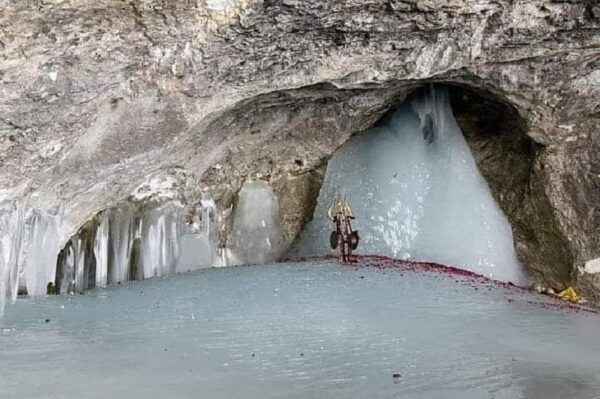
Shiva, the reminiscent, the formless and the ever bountiful giver. It is impossible to describe this source of energy in words and all the more difficult to describe the pilgrimage to the holy shrine of Amarnath.
The famous Amarnath cave which is situated in a narrow gorge at the farther end of Lidder Valley. Amarnath Shrine stands at 3,888m, 46 Km from Pahalgam and 14 Kms from Baltal. However, by matter of chance the pigeons’ overheard the katha and became immortal. Many pilgrims report seeing the pigeons in this area.
Having known the legend of this holy shrine Amarnath. Lets understand the months when Amarnath Yatra starts, two routes which one can choose to undertake to reach the shrine, some health precautions, the accommodation tariffs in various camps, the transportation for the shrine by ponies, palanquines, Helicopter rates, and other miscellaneous do and don’ts.
Also Visit: Plan a Trip to Kedarnath Yatra
Months when the Amarnath shrine is open for visit
The Amarnath Shrine is open for visitors to pay respects typically from end of June to 1st week of August. The dates for this year are 21rd July 2020- 3rd August 2020.
There are two routes, before undertaking this route one has to understand that one can alight at either Jammu or at Srinagar to take the onward Amarnath Yatra.
- Pahalgam
- Baltal
THE PAHALGAM ROUTE
Pahalgam: The distance between Jammu to Pahalgam is 315 Km which can be covered by taxi/ buses only early in the morning. Alternatively one can fly till Srinagar and undertake the journey to Pahalgam by road. The distance from Srinagar to Pahalgam is 96 Km. The first halt for Amarnath pilgrims is at Pahalgam.
Chandanwari: The distance from Pahalgam to Chandanwari is 16 kms. Mini buses run from pahalgam to chandanwari.
Pissu Top: The distance between Chandanwari and Pissu top is approx 16 kms again.
Sheshnag: Sheshnag is a 12 Km trek from Sheshnag. Right from CHandanwari to sheshnag the beauty of the nature lies untouched by civilization. Hence, one gets bewitched by the scenic beauty of these places. Absolute solitude, one starts undertaking an inward journey to discover oneself. Sheshnag is where there is a 2nd night halt.
Panchtarni: is a very beautiful place in the feet of Mount Bhairav. From Sheshnag one has to climb steep height across Mahagunas Pass at 4,276 m (14,000 ft) for 5 km and then descend to the meadows of Panchtarni located at a height of 3,657 m. 3rd night halt is taken at Panchtarni. One may feel nauseated or may get affected by the deficiency of oxygen levels. The same route can be undertaken via helicopter for Rs 6000/- approx.
Holy Amarnath Cave: The holy cave is 5 km trek from Panchtarni, one comes across the Sangam of Amravati and Panjtarni rivers. Some pilgrims take bath at Amravati near the Holy Cave before going for Darshan. There are two smaller Shivlings one of Maa Parvati and other of Shri Ganesh. It may be noted that after having early Darshan of the Shiv Linga at Holy Cave, one can return to Panjtarni well in time the same day. Depending upon the weather conditions one can fly back to Pahalgam. If the weather conditions are not favourable then one may need to stay at panchtarni. The camps are build which range roughly about Rs 400/- .
THE BALTAL ROUTE
This route can be taken via Jammu or via Srinagar. From Jammu the road will be Jammu – Udhampur – Kud – Patnitop – Ramban – Banihal – KaziGund – Anantnag – Srinagar – Sonamarg – Baltal. The distance will be 400 Kms.
The journey from Jammu to Baltal is 400 Kms, passes through beautiful valleys, waterfalls, and greenery all over will help you rejuvenate.
Alternatively, one can reach Srinagar by flight and reach Baltal via sonmarg. The distance is 107 Km approx from Srinagar airport to Baltal. The Holy Cave is 14 Km from Baltal. One can undertake the helicopter ride from Neelgranth which is located in sonmarg district to Panchtarni. The approximate cost is Rs 4000/-
Also Visit: Char Dham Yatar – Tha Way to Attain Moksh
DO’s & DON’TS FOR AMARNATH YATRA
DO’S:
- One needs to undertake 4-5 Km walk to improve the oxygen efficiency for the body.
- You must carry (i) adequate woolen clothing; (ii) a small umbrella (preferably one which is tied with an elastic band around your head and supported by a strap around the chin); (iii) windcheater; (iv) raincoat; (v) waterproof trekking shoes; (vi) torch; (vii) walking stick; (viii) cap (preferably a monkey cap); (ix) gloves; (x) jacket; (xi) woolen socks; (xii) trousers (preferably a waterproof pair). These items are essential as the climate is highly unpredictable and changes abruptly from sunny weather to rain and snow. The temperature can sometimes abruptly fall to 5 degrees Celcius or lower.
- Ladies are advised to wear salwaar Kameez or track suit or pant-shirt. Ladies who are moer than 6 months pregnant will not be allowed to undertake the yatra.
- Children below 13 years of age and elderly above 75 years are not allowed to undertake the yatra.
- Try to carry dry fruits, gur, toffees, water with you for the journey.
- Avoid trekking alone. During the yatra from Pahalgam/Baltal one should keep an extra pair of clothing incase of sudden shower.
- Suggested to carry sunscreen, Vaseline to protect hands against sunburn.
- One needs to keep phone number, name, address of the member of your group with whom you are travelling should need any emergency help. You must also carry your Yatra Permit and any other identity card.
DON’TS
- Don’t stop at places which are marked by warning notices.
- Don’t use slippers because there are steep rises and falls on the route to the Holy Cave. Only wear trekking shoes with laces.
- Don’t attempt any short cuts on the route as doing so would be dangerous.
- Use of plastics is an punishable offence under law.
PLEASE HELP KEEP THE ENVIRONMENT CLEAN , NO BEHAVIOUR WHICH IS DETRIMENTAL TO THE ENVIRONMENT WOULD BE APPRECIATED.
Advisory to avoid Hypothermia
Cold weather conditions in high altitude sites in the yatra area wherein the temperature abruptly falls 2 – 5 degree Celsius , yatris especially elderly people may suffer from hypothermia.
Symptoms of Hypothermia
The first sign of Hypothermia is Shivering as the temperature starts to drop because as your body automatically goes into the defence against cold temperature — an attempt to warm itself. The following are the signs and symptoms of hypothermia:
In mild to moderate cases
- Shivering
- Slurred speech or mumbling
- Slow, shallow breathing
- Weak pulse
- Clumsiness or lack of coordination.
In severe conditions
- Drowsiness or very low energy
- Confusion or memory loss
- Loss of consciousness
Following measures are suggested to prevent Hypothermia
- Diet should consist of plenty of fluids with warm drinks and regular meals can help provide energy required by the body to generate heat.
- Avoiding of alcohol, caffeine and smoking as they all increase the rate at which the body loses heat.
- During sleep also, the body should be covered with warm clothes including covering the head and feet.
- Before going to sleep, making sure that the underclothes are not wet due to sweat as wet clothes lose around 90% of their insulation power
- Avoid bathing during night times even with hot water.
Yatries are also required to bring with them adequate woolen clothing; jacket; warm inners; woolen socks; gloves; cap (preferably a monkey cap ); trousers (preferably a waterproof pair); muffler, sleeping bag; windcheater; raincoat; waterproof shoes; Umbrella (preferably one which is tied with an elastic band around your head and supported by strap around the chin).
Health Advisory
- The Pilgrimage to Holy Cave of Shri Amarnathji involves trekking at altitudes as high as 14000 feet.
- Yatris may develop High Altitude Sickness with following symptoms: loss of appetite, nausea, vomiting, fatigue, weakness, dizziness, lightheadedness and difficulty in sleeping, visual impairment, bladder dysfunction, bowel dysfunction, loss of coordination of movements, paralysis on one side of the body, gradual loss of consciousness and mental status changes, drowsiness, chest tightness, fullness, congestion, fast breathing and increased heart rate.
- If high altitude sickness is not treated timely, it may be lethal in a matter of hours.
Telecom Facilities:
BSNL connectivity shall remain available en route upto Holy Cave. Only postpaid connections are allowed, pre-paid connections are not allowed in J&K. Alternatively, special Pre-loaded Yatra SIMs are being provided by BSNL to Yatries with the approval of Ministry of Home Affairs/DoT.
The cost of Yatra SIM is Rs. 230/- ( including the cost of STV and Plan Voucher) with 20000 sec. free talk time and 1.5 GB Free data usage and validity of ten days. For obtaining the BSNL Pre-loaded Yatra SIM card, valid documents such as
1) Proof of Address,
2) Proof of Identity and applicants photograph are required to be submitted by the Yatries along with a photo copy of counterfoil of Registration Slip issued by SASB which shall be considered as local reference.
For more information contact Swastik Holiday.






